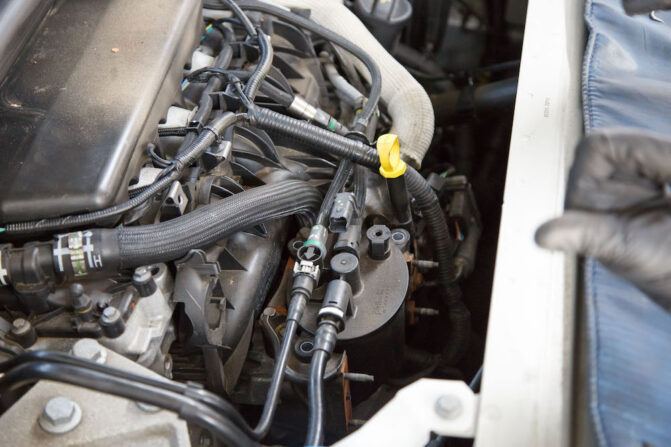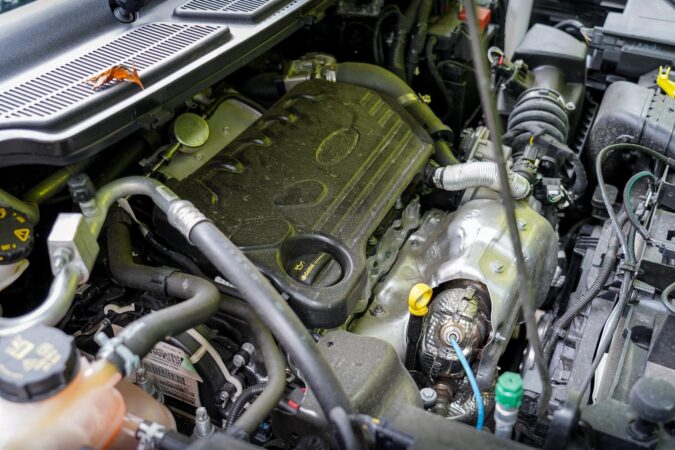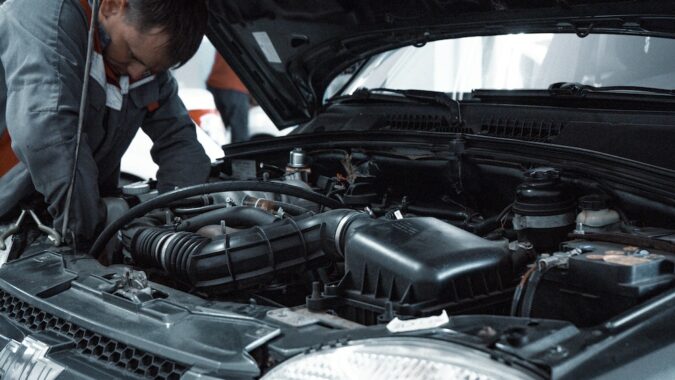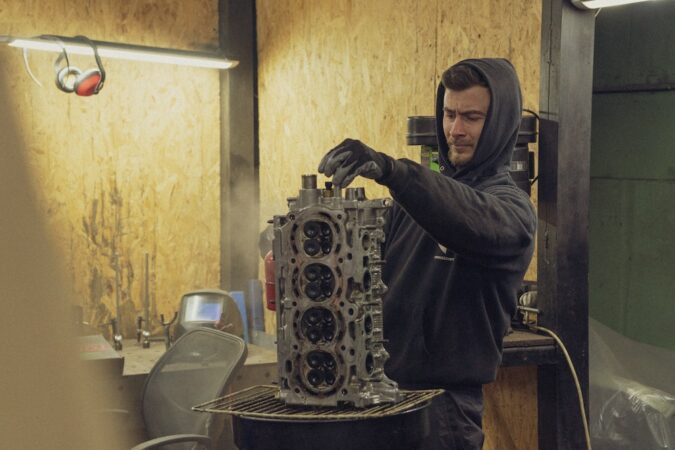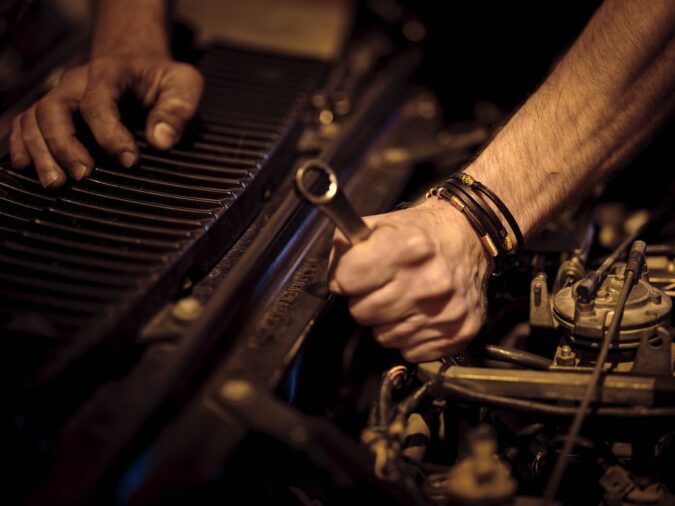The intake manifold is a collection of tubes that distributes the air-fuel mixture throughout the cylinder. Its job is to make sure that the air coming to the engine is dispersed evenly across the cylinders. As this component is supposed to strictly handle the air-fuel mixture in the engine, you may ask what happens if there is oil in the intake manifold.
If there is oil in the intake manifold of your vehicle, it can be signaling an underlying problem. For instance, the oil leak may be so bad that the intake manifold has finally been affected. Whatever the reason is, you have to diagnose and repair it as soon as possible.
When there is oil in any part of the car where it should not be, that means there is oil leakage in the system. In this article, we will take a deep dive into intake manifolds and what to do when there is oil accumulated in this component.
- Oil In Intake Manifold
- Signs Of Leakage
- Reasons
- Tips To Prevent
- Replacement Cost
- Intake Manifold Repair
- FAQs
Can Oil Leak From The Intake Manifold?
Yes, oil can leak from the intake manifold. Engine oil travels through certain passages that work collectively to lubricate parts of the engine. But, the intake manifold does not need lubrication. If your car has oil in the intake manifold, there is an oil leak in the system that needs to be addressed immediately.
In general, if the engine oil is incapable of flowing freely through the designated pipes, it is stored at the top of the cylinder head. The oil will move to the air intake manifold through the Positive Crankcase Ventilation Valve or PCV valve after shutting down the channel completely.
One more thing to remember is that the intake manifold can leak both engine oils and coolant. In the event of such an issue, you must take out the intake manifold before replacing it with the gasket.
Should There Be Oil In The Intake Manifold?
Under any circumstance, there should not be oil in the intake manifold. There is nothing to worry about if you can only see a thin layer of oil. That is natural and nothing much can be done about it. If you observe a little oil stock or puddle within the manifold, however, you may want to bring the vehicle to a service center.
Worrying volumes of oil inside the intake manifold is a sign that the engine has worn out and is not working to the best of its capacities.
How Bad Is It To Have Oil In Intake Manifold?
Oil in the intake manifold can be both a complicated issue and a simple one. It generally depends on how much oil is in there. For example, we mentioned that a thin layer of oil is fine and nothing to be concerned about – it happens from time to time. You can continue driving your car like you used to.
But, when the oil stuck inside the manifold has formed a puddle, that is the moment to start worrying. Fortunately, this problem does not call for immediate attention and will not cause life-threatening issues soon. Take it as a wake-up call from your engine as it ages and asks for the replacement of numerous parts.
We highly recommend getting it diagnosed by a professional – perhaps an auto repair shop or your local dealership. They can better guide you on which parts require replacement or repair.
Signs Of Leakage In Intake Manifold
Your car will give you multiple signs of leaking inside the intake manifold and it is your job to comprehend them before it’s too late. The following are a few of the indications to keep an eye out for:
- Rough idling and backfires (happens when there is a mismatch between the air to fuel ratio in the engine oil)
- Engine oil looks milky
- Coolant leaks out of the engine when the vehicle is idling
- Frequent engine overheating
Has the intake manifold been checked out by a mechanic if you suspect there is any sort of problem with it? Remember, prevention is better than cure.
Reasons Behind Oil In Intake Manifold
Why and how does oil seep into the intake manifold. This issue can take place due to some reasons:
1. Clogged Air Cleaner Filter
Not only humans but cars also need clean air. Auto mechanics always advise their clients to ensure clean air is available for their vehicles at all times to improve engine performance. Almost every engine maker from the likes of Toyota to BMW and Mercedes gives more attention and specializes in good air cleaners for cars. These companies like to use turbochargers in their engines.
A turbocharger makes sure that your engine offers the best performance with great fuel efficiency. Of course, we all want to enjoy a fast and smooth ride while saving money on it. With the rising costs of gas, fuel-efficient vehicles are all the rage. Engine makers put a lot of effort into these air cleaners so we should consider doing our part and keep an eye on the turbocharger.
Powered by the motor exhaust gases, a turbocharger will fail to work if the exhaust system is not in great condition. After all, the system is what runs the turbo. When you are investing time and effort (and maybe money) to keep the turbocharger running for a long time, your engine will reciprocate with better performance. In the end, you will find that you have saved money and received optimum performance.
The air cleaner of your vehicle may be jammed or clogged if you think inadequate air is being taken in by the engine. In that case, gas will repeatedly go through the combustion chamber. As a result, you will see black smoke from your vehicle’s exhaust which may even be smelly.
Exhaust gases like this can weaken the turboshaft bush’s bearing. Eventually, the issue will exacerbate and oil will end up in the intake manifold surpassing the turbo. Therefore, we strongly suggest cleaning your car’s air cleaner or replacing it when needed.
This replacement is not that expensive (in comparison to other repairs/replacements you might need to do if the problem worsens). At the same time, it will prolong the life of your turbo and engine.
2. Malfunctioned PCV Valve
A faulty PCV valve can be the reason behind the oil in the intake manifold. If you suspect there is oil in the intake manifold, have it inspected as soon as possible. A blocked PCV valve is quite common in today’s cars.
We recommend checking the system in general. Carefully examine the parts to understand where the problem lies. If the problem is indeed being caused by a poor PCV valve, have it replaced as soon as possible. A bad PCV valve can cause imbalanced airflow.
Consequently, a little soil can get inside the air intake as well. Apart from that, a problem with the PCV valve will trigger your vehicle’s CEL or Check Engine Light. The Check Engine Light can be on for several reasons, so look into the other possible issues too.
Moreover, a malfunctioned PCV valve can store a problem code in your vehicle’s OBD-II system. Codes like P053C, P053A, P0171, P0174, or P053E are all indicative of possible PCV valve issues. You can check these codes with a code scanner tool or have an auto repair specialist have a look.
The best solution we can think of is cleaning (check out this video). It will do the trick for minimal to moderate clogging. However, if simply cleaning cannot solve the huge clog, a professional is the only way to go.
The Role Of PCV System In The Car
Positive Crankcase Ventilation systems are a replacement for Crankcase Venting Systems. They take out all the emissions from your engine and vent them directly into the atmosphere. Those emissions are caught by the PCV systems which then redirect them to the engine where they are burned with the combustion process.
PCV systems have only been complicated over time, even more so over the past decade. These upgrades were necessary to decrease the amount of oil PCV systems can revert to the engine. Moreover, system complexity was important to handle the problems regarding super and turbochargers and the blowby they have on the crankcase.
These systems can accidentally move engine oil to the throttle body, intake manifold, and intake piping. The rotary machinery’s key components are located within the crankcase and nearby enclosed areas. Areas like this are interconnected and closed from the outside.
As the engine is operating, excessively high pressure formed inside the combustion chambers forces exhaust gases to pass through the piston rings to the crankcase. We call this blowby. Since blowby is normal and inevitable, there is nothing to be concerned about.
In low mileage or new vehicles, there isn’t much leakage. With age, the car sustains wear and tear on the piston rings which causes the rate of leakage to rise.
How Does The PCV System Work?
Had the crankcase not had any vents, blowby would sharply raise the pressure within. Oil leakage would follow soon after through the numerous gaskets and seals of the engine.
In this process, the vapors formed contain heated water and air (combustion’s by-products), a little volume of fine oil drops, and unburnt fuel vapors interlaced in the fuel-air mixture.
The piping vents of the PCV system send these vapors to 2 areas, the intake manifold between the intake valves and throttle body, and the air inlet tubing within the throttle body air filter. Blowby vapors will reach both inlet positions, but the air also moves back to the crankcase when the engine vacuum happens.
Furthermore, the PCV valve is tasked with moderating the flux in both directions and regulating the flux rate of blowby to decrease its overall effect on the air-fuel mixture. In some vehicles, the system piping ends at a port inside the air filter rather than the inlet tubing.
Note: Apart from the Positive Crankcase Ventilation systems, there are no others inlets for oil into the intake system. Thus, if there is oil in the intake manifold, rest assured, that the PCV system was somehow thrown into the mix.
3. Clogged Oil Passage
Another major reason oil may find its way to the air intake manifold and eventually block the air filter is blocked oil passages. It is important to replace the oil filter and engine oil as recommended by the manufacturer or this could result in clogs.
Excessive engine sludge or carbon deposits can develop inside the crankcase, leading to this situation. Additional engine oil pressure forms when the oil is unable to flow properly, causing the spare oil to pass through the PCV valve. As you can see, the PCV valve is still involved here as mentioned earlier.
What to do in this situation? In this instance, replacing the filter, engine oil, air filter, and PCV valve should be enough. But, if you discover blocked oil galleys, we recommend flushing the engine oil and replacing the oil filter twice (at the very least) within 1,000 miles to make sure there is no debris within the engine oil passages.
4. Damaged Piston Rings
Broken piston rings are another reason there can be oil damage to the intake manifold. The piston rings are situated on the outer corner of the pistons within the exhaust chamber. Their job is to make an exhaust ratio and allow little volumes of engine oil to continually grease the inner exhaust chamber amidst every piston stroke.
Loose piston rings can result in oil blowby. One way to understand your engine is suffering from blowby is blue smoke emitting (in addition to seeing blue smoke from exhaust on startup) from the vehicle’s tailpipe during drives.
When worn pistons rings are still in their early stage, excess oil blowby results in excessive pressure formation in the crankcase. This, in turn, transmits additional oil through the Positive Crankcase Ventilation systems and inside the air intake.
The solution: If you find engine oil in the intake housing or the air filter, a compression test might be the best solution under the guidance of a professional mechanic. The mechanic will set up one compression gauge on each of the spark plug holes to examine the compression of every cylinder.
If the results are lower than ideal, worn piston rings can be the reason. Sadly, fixing this situation is not as easy as changing a PCV valve. It may be a wise decision to replace your vehicle if the source of problems is indeed worn piston rings. Changing rings and pistons will cost you more than the valve of your car.
5. Aging Engine Problems
Older engines (with more than 150,000 miles on them) are expected to show signs of uncontrolled blowby. Symptoms include rough running, smoky exhaust, and rough idle. In this case, the least of your problems will be engine oil in the intake manifold and throttle body. The only course of action here would be an engine rebuild – and fixes like this do not come cheap.
Tips To Prevent And Stop Oil From Getting Into Intake Manifold
As mentioned before, we strongly suggest cleaning the air cleaner and intake manifold of your vehicle at regular intervals. Simple things can go a long way in preventing oil leakages in the engine, especially in the intake manifold.
If you observe any of the issues we talked about above or suspect 1 or 2 of them eating at your vehicle right now, time to get to work. Don’t try to handle the issues yourself if you possess no automotive knowledge.
Feel free to reach out to an experienced mechanic nearby. They will give you a better idea of what needs to be done to stop the same problems from recurring.
Replacement Cost Of Intake Manifold Gasket
An intake manifold gasket’s replacement cost will set you back anywhere between $190 and $540. Cost of labor occupies the lion’s share of these prices, coming in at $170 to $240 whereas the gasket is usually cheap and goes for the ballpark of $20 to $120.
If you own a car with a V6, V8, or similar engine layout with numerous cylinder banks, your car might have a few manifold gaskets. Unfortunately, all of them have to be changed at the same time.
Plus, you have to worry about the extra charges and taxes. Overall, intake manifold gasket replacement is not the most replacement job your car will ever need and it should be doable for most drivers.
When To Get Intake Manifold Repair?
Automakers design intake manifolds to make them last the entire life of your engine. However, different issues can cause them to deteriorate soon. The components of the gaskets as well as the gasket itself can create issues a lot sooner, making it crucial to know what the warning indications are.
Listen for unnatural sounds coming from the engine, rough performance, every check engine light, and sooty smoke. There are few potential signs of these problems. It’s better to be on the safe side and have your vehicle checked out by a mechanic if you aren’t sure what the root of the issue is.
Can You Drive With A Bad Intake Manifold Gasket?
Yes, you can drive with a bad intake manifold gasket. That being said, while driving in that condition possible, refrain from dreaming to cross long distances. Problems like this are not solved by leaving the engine to deal with it, and they do not get better over time.
Leaking excessive air into the exhaust chamber can make your vehicle run lean, consequently making it run hotter. Predestination or knock is also likely. Over-the-top knocking under load is capable of destroying a perfectly stable engine.
Overheating in the engine can cause damage to the surrounding parts, including a cracked block or cracked or warped head. Repairing this will be much costlier than replacing a basic intake manifold gasket.
Intake Manifold Facts: What Causes Oil in the Intake Manifold and How to Fix It
- The intake manifold is responsible for distributing the air and fuel mixture to the cylinders in the engine.
- There are two main types of intake manifolds: directly injected and port-injected.
- Generally, there should not be any oil in the intake manifold, and if there is, it means there is a problem with the engine.
- The most common reasons for oil in the intake are a bad PVC valve or clogging in the oil passage.
- Symptoms of oil in the intake manifold include engine smoke and reduced engine power.
- You can use a smoke machine or a pressure tester to detect leaks in the intake manifold.
- To fix oil in the intake manifold, you need to remove the negative battery terminal, the oil dipstick, and the PCV valve and clean the entire intake manifold using a degreaser.
- The best way to prevent oil in the intake manifold is to regularly change your engine’s oil and use a quality air filter.
- Carbon buildup on the intake valves can be caused by oil burning in the engine and is more likely to occur in direct injection engines.
- It is not recommended to switch between different types of oils in your car without consulting the owner’s manual or a qualified mechanic.
Final Thoughts
In a nutshell, oil in the intake manifold signs oil leakage in the engine and tells you that your engine has begun to deteriorate. The gravity of this situation is determined by the volume of oil lodged in the inlet manifold.
If you notice a thin oil coating, that can be cleaned and you can go about your day. However, if there is a little puddle of oil in there, visit a mechanic as soon as possible for a thorough cleaning. You may have to repair some broken bits here and there.
Frequently Asked Questions (FAQs)
Here are some popular FAQs:
Q: How Long Do PCV Valves Last?
A: PCV valves do not come with a specific expiry date. It does not have any certain lifespan routine. It largely depends on PCV valve care and maintenance. Much like any part of the car, proper maintenance increases the lifespan of the valve. That does not dispel the need for a major routine service such as 30k or 90k. The PCV can and will wear out between services.
Q. Can Oil In Intake Manifold Cause Misfire?
Oil in the intake manifold is among the common reasons for engine misfires. A broken intake manifold gasket changes the engine air, the primary element in full ignition. A horrible enough break will allow enough air to seep out, hindering the burning.
Q) How Do You Remove Oil From The Intake Manifold?
Frequent cleaning can help car owners remove oil from the intake hose easily. You can use a degreaser or kerosene to clean it. Apply a layer of it using a brush and allow it to work its magic for 10 to 15 minutes before rinsing it off. In case the cleaning wasn’t the best the first time, rewash it.
Q) Can clogged Air Filters Increase Oil Consumption?
Yes, clogged air filters may indeed do that. A blocked air channel will become a bigger restriction for the intake system, resulting in more vacuum levels. Taking the engine has worn/feeble oil seals already, having a greater vacuum can suck oil across these and get the engine to burn oil.
Q) Can A blocked PCV Valve Increase Oil Consumption?
A clogged hose, PCV framework, or bad valve can reduce fuel efficiency sharply as pressure changes when the crankcase’s fumes are not allowed to move to the combustion chambers. The additional strain can force oil past gaskets and seals.

